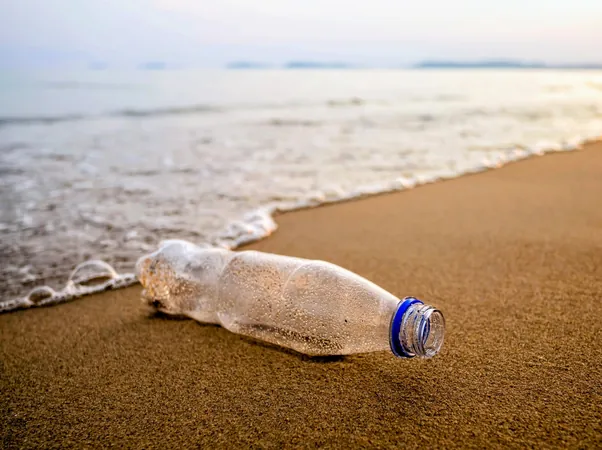
Revolutionizing Ocean Cleanup: How Space Technology Could Save Our Seas
2025-03-24
Author: Yu
Ocean currents, the lifeblood of our planet's ecosystems, are shifting dramatically under the weight of human excess. Once pristine, these vast waters are now marred by an alarming amount of waste, with the infamous Great Pacific Garbage Patch epitomizing this crisis. Spanning a staggering area greater than Texas, this massive collection of floating plastic is a haunting reminder of our environmental negligence.
However, the problem of ocean pollution extends far beyond just this infamous patch. Globally, a network of invisible highways—comprised of ocean currents—connects coastlines, inadvertently transporting everything from plastic bottles to abandoned fishing nets. The challenge of cleaning our oceans has long been hindered by the exorbitant costs and logistical nightmares of traditional cleanup efforts.
But what if we could turn the tide on this growing catastrophe using innovative technology? A breakthrough study from the journal Ocean Science proposes a game-changing strategy: instead of actively chasing down the waste, what if we let the ocean currents do the work for us?
Harnessing Ocean Currents for Cleanup
Recent advancements in satellite technology and the comprehensive tracking of ocean currents have enabled scientists to pinpoint areas where trash naturally accumulates. By focusing on these “hotspots,” environmentalists could revolutionize the way we tackle ocean pollution. Rodrigo Duran, a research scientist at the Planetary Science Institute, highlights the potential savings: "With this information, we can let the currents do the work," he explains. This approach allows cleanup crews to position nets strategically at locations where floating debris is likely to aggregate, reducing the need for fuel-intensive boats.
The Pioneering Study and Its Implications
Led by graduate student Luca Kunz from the University of Hamburg, this study is backed by The Ocean Cleanup, a Dutch nonprofit committed to developing advanced waste removal technologies. The researchers analyzed over two decades’ worth of satellite observations and data from drifters—floating devices that provide real-time tracking of water movements.
This extensive analysis unveiled an astonishing 3.5 million Transient Attracting Profiles (TRAPs)—temporary zones where ocean currents converge, creating ideal conditions for collecting debris. Though these zones last only about six days, they present critical windows for efficient cleanup operations.
Understanding the Geometry of TRAPs
Interestingly, not all TRAPs are created equal. The research identified optimal configurations that stabilize these transient zones, enabling more effective cleanup strategies. The most frequent and efficient arrangement consists of four interacting eddies—circular currents—that form these zones. A predictable pattern emerges, allowing scientists to plan cleanup missions with greater accuracy.
Beyond Garbage: New Applications for Ocean Data
The potential applications of this research extend far beyond recycling plastic. Insights gleaned from TRAPs can enhance emergency response strategies, from search and rescue missions to tracking oil spills and monitoring airborne hazards after natural disasters. Duran emphasizes that understanding how ocean currents operate could prove invaluable in a variety of scenarios, including when volcanic eruptions or wildfires disrupt air travel.
Collaborating for a Cleaner Future
This groundbreaking research represents a collaboration across several countries, bringing together data science expertise from Germany, practical applications from the Netherlands, and innovative environmental solutions from the U.S. By embracing a more holistic and nature-friendly approach, we can learn to effectively manage the waste we’ve left in our oceans.
The path forward remains full of challenges, but the clarity is undeniable: the ocean is not merely a victim of human actions—it is a dynamic system capable of aiding our attempts at restoration. As we further unveil the mysteries of ocean currents through cutting-edge science, there is hope that we may finally reverse the damage we have done and secure a cleaner, healthier future for our oceans.
This transformative research illustrates the promise of innovation in addressing one of the planet's most pressing issues. Utilizing the ocean's own capabilities might just be the key to reclaiming our seas before it’s too late.



 Brasil (PT)
Brasil (PT)
 Canada (EN)
Canada (EN)
 Chile (ES)
Chile (ES)
 Česko (CS)
Česko (CS)
 대한민국 (KO)
대한민국 (KO)
 España (ES)
España (ES)
 France (FR)
France (FR)
 Hong Kong (EN)
Hong Kong (EN)
 Italia (IT)
Italia (IT)
 日本 (JA)
日本 (JA)
 Magyarország (HU)
Magyarország (HU)
 Norge (NO)
Norge (NO)
 Polska (PL)
Polska (PL)
 Schweiz (DE)
Schweiz (DE)
 Singapore (EN)
Singapore (EN)
 Sverige (SV)
Sverige (SV)
 Suomi (FI)
Suomi (FI)
 Türkiye (TR)
Türkiye (TR)
 الإمارات العربية المتحدة (AR)
الإمارات العربية المتحدة (AR)